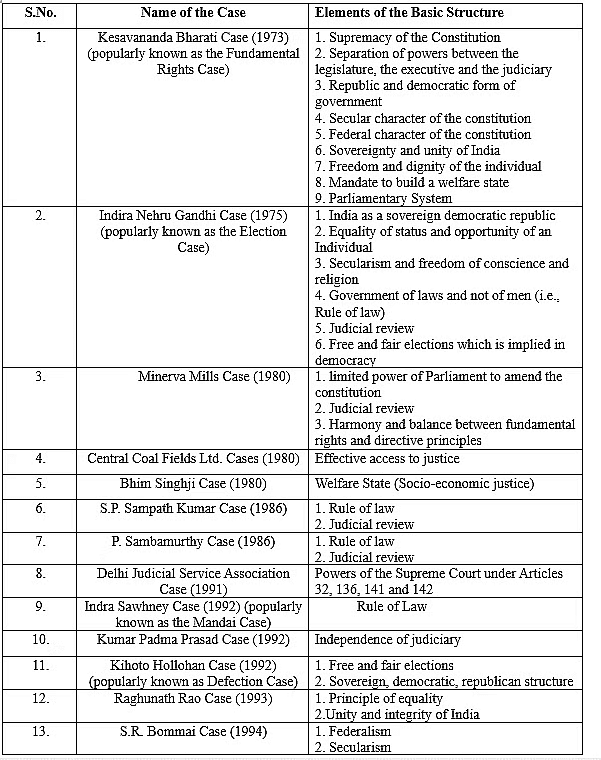Laxmikant Summary: Basic Structure of the Constitution | Indian Polity for UPSC CSE PDF Download
Introduction
The supreme law of India is embodied in the constitution, a written document that establishes the fundamental framework delineating the basic principles, structure, procedures, powers, and responsibilities of the government and its institutions. Additionally, it outlines the rights and duties of the citizens.

Emergence of the Basic Structure
- The Supreme Court deliberated on the Parliament's authority to amend Fundamental Rights under Article 368 shortly after the Constitution's enactment.
- In the Shankari Prasad case (1951), the Court affirmed the constitutional validity of the First Amendment Act (1951), asserting that Parliament's power under Article 368 includes amending Fundamental Rights.
- Article 13 was interpreted to cover only ordinary laws, not constitutional amendment acts, allowing Parliament to modify or revoke Fundamental Rights without violating Article 13.
- The Golak Nath case (1967) saw a reversal in the Supreme Court's stance, declaring Fundamental Rights as 'transcendental and immutable,' and ruling that Parliament cannot diminish or abolish these rights through a constitutional amendment act.
- In response to Golak Nath, the 24th Amendment Act (1971) explicitly granted Parliament the power to abridge or revoke Fundamental Rights without such acts being considered laws under Article 13.
 Shankari Prasad
Shankari Prasad
- The Kesavananda Bharati case (1973) validated the 24th Amendment Act, affirming Parliament's authority to alter Fundamental Rights but introduced the 'basic structure' doctrine, emphasizing limits on modifying the Constitution's fundamental framework.
- The Indira Nehru Gandhi case (1975) saw the 'basic structure' doctrine applied, invalidating a provision of the 39th Amendment Act (1975) for affecting the Constitution's basic structure.
- Parliament responded with the 42nd Amendment Act (1976), asserting unlimited constituent power and immunizing amendments from judicial review.
- The Minerva Mills case (1980) struck down the provision in the 42nd Amendment Act, underscoring Parliament's limited amending power.
- The Women's Reservation cases (1980) reaffirmed the 'basic structure' doctrine, extending its application to constitutional amendments enacted after April 24, 1973, the date of the Kesavananda Bharati case judgment.
Elements of the Basic Structure
The current standpoint is that Parliament, as per Article 368, has the authority to amend any segment of the Constitution, including Fundamental Rights, as long as it does not impinge upon the 'basic structure' of the Constitution. Nevertheless, the Supreme Court is yet to provide a precise definition or clarification regarding what constitutes the 'basic structure' of the Constitution. Based on various judgments, the following have emerged as elements or 'basic features' of the Constitution:

 Evolution of the Basic Structure of the Constitution
Evolution of the Basic Structure of the Constitution
- Supremacy of the Constitution
- Sovereign, democratic, and republican nature of the Indian polity
- Secular character of the Constitution
- Separation of powers among the legislature, executive, and judiciary
- Federal character of the Constitution
- Unity and integrity of the nation
- Welfare state (socio-economic justice)
- Judicial review
- Freedom and dignity of the individual
- Parliamentary system
- Rule of law
- Harmony and balance between Fundamental Rights and Directive Principles
- Principle of equality
- Free and fair elections
- Independence of the Judiciary
- Limited power of Parliament to amend the Constitution
- Effective access to justice
- Principles (or essence) underlying fundamental rights
- Powers of the Supreme Court under Articles 32, 136, 141, and 142
- Powers of the High Courts under Articles 226 and 22.
|
147 videos|780 docs|202 tests
|
FAQs on Laxmikant Summary: Basic Structure of the Constitution - Indian Polity for UPSC CSE
| 1. What is the Basic Structure of the Constitution? |  |
| 2. How did the Basic Structure of the Constitution emerge? |  |
| 3. What are the elements of the Basic Structure of the Constitution? |  |
| 4. Can the Basic Structure of the Constitution be amended? |  |
| 5. Why is the Basic Structure of the Constitution important? |  |
















